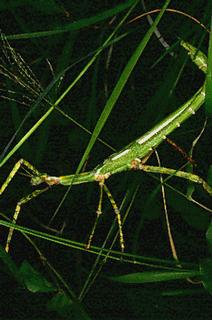

 |
 |
Order
- PHASMATODEA
(Greek, phasma = apparition, phantom)
Common Names: stick insects, leaf insects,
walking stick insects
Distribution: Warmer parts of world,
especially the tropics
Description
All phasmids consume plant material (phytophagous) and are remarkable for
their ability to mimic twigs, stems, leaves and sticks. Their bodies are
as varied as the vegetation they inhabit. Dry grass stems are inhabited by
species that are brown with cylindrical bodies and long tubular legs.
Foliage species may have bodies that are flattened and leaf-like with legs
that bear equal resemblance to foliage. Wings may be present or absent. If
wings are present, then the forewings are leathery and form protective
covers (tegmina), the rear pair are used for flight. In winged species,
only the males are capable of flight. Compound eyes are present and simple
eyes (ocelli) are only present in winged species. Mandibles are well
developed. The antennae are composed of short, straight segments (filiform).
Phasmids
actively feed during the night hours and generally remain motionless
during the day.
Nymph
There is no metamorphic cycle of egg, larva, pupa and adult. The juveniles
emerge from the eggs as miniature, wingless versions of the adults
(nymphs) and mature by successive moults. Nymphal stages can be
differentiated from adults by their smaller size, fewer antennal segments
and in winged species, a lack of wings. Mimicry also extends to the eggs.
Many species lay eggs that resemble plant seeds.
Members
Phasmids, leaf insects, stick insects, walking stick insects.
Food
Stick insects feed on fresh vegetation, usually the foliage of the plant
on which the insect is found.
Importance
Apart from their use by other organisms as food, phasmids are generally
not of any great significance in ecosystems. When present in enormous
numbers (which does occur in eucalypt forests at intervals) damage may be
significant. When plague proportions of stick insects are reached, whole
tracts of forest can be defoliated and seriously damaged. In some parts of
eastern Australia, local names such as "Ringbarkers" have been
applied to stick insect depredations due to the dying brown appearance of
the forest after the swarms have passed through. |